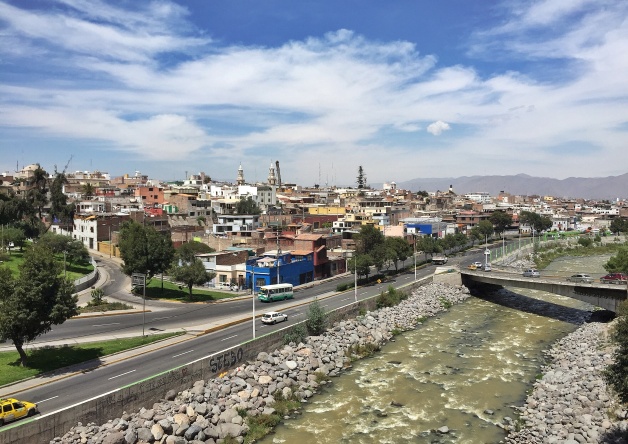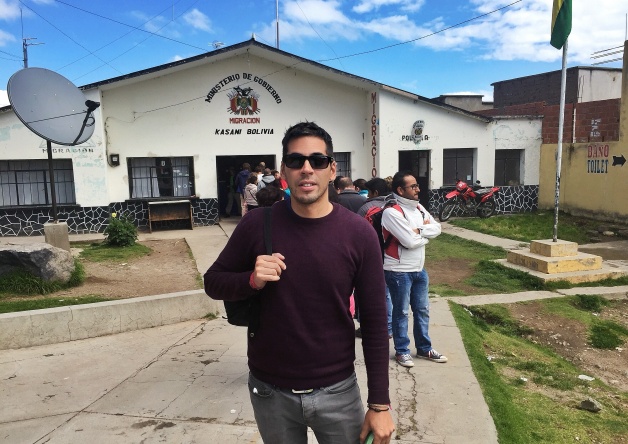Round the World trip
November 2014 – May 2015
week 21 of 24
PERÚ
The South
by Simon
There is really only one reason tourists visit Nazca, and that is to see the Nazca Lines, a series of lines, geometrical shapes and animal and plant figures etched on the desert by the Nazca people some 2,000 years ago. The lines cover a large area and some of the individual figures are over 100 meters across. They may have represented constellations, or heavenly figures, or have been fertility symbols; nobody really knows. German archeologist Maria Reiche dedicated much of her life to the study of the lines and is commemorated throughout the town (although some murals of her made her look like Harry Potter or a gorilla, so not entirely flattering).
The lines are best viewed from the air early in the morning, when there is better visibility and less turbulence; therefore we were at Maria Reiche Aerodrome shortly after 7am for our short flight with AeroParacas, which we were told has a better safety record than some of the other operators (which doesn’t say much). The pilots didn’t exactly go out of their way to explain what we should be seeing, and the sound system on the plane was so unclear we could hardly hear them anyhow. However, we did see a range of shapes including a condor, monkey, whale, hummingbird, spider, and some hands – although I only really know this by comparing my photos with the diagram the airline provided telling us what we should have seen.
above: the Hummingbird (bottom left), and the Whale (bottom right); below: the Spider (top left), the Hands – or the Frog – and the Tree (top right), and the Condor (bottom right)
We were back in our guesthouse by 9am, where owner Nancy had breakfast waiting for us. At this point Xavier went back to bed, and I joined Grace and Jason for a quick tour of Nazca’s other sites. This included other lines that can be seen from hills, and an underground aqueduct system built by the Nazca but still used today, which brings water down from the Andes to the desert below, enabling some of the area around the town to be used for agriculture.
And that was Nazca. 24 hours after arriving, we were already on the bus out. After our unfortunate experience with the económico bus between Máncora and Trujillo, we had tried to stick with the largest bus company, Cruz del Sur, but they were full this time and so we used their competitor, Oltursa, for what should have been a nine hour trip to our next stop, Arequipa – it’s amazing how 9-12 hour bus trips, a prospect which would horrify most people in the UK, have now become routine for us. This company also provided a modern, comfortable bus – we could even turn off the speaker above our heads so we didn’t have to be deafened by the dubbed versions of Son of Rambow and other equivalently exciting films they played on the video. Unfortunately, Peruvian bus schedules seem to express hope more than expectation, and it was past 1am when we pulled into Arequipa. Apologies to the manager of our lovely hostel for keeping her up until we arrived.
Arequipa is the third-largest city in Perú, but only a tenth the size of Lima. It is a well preserved colonial city with more impressive churches and museums. There is a free walking tour every day at 3pm from Plaza de Armas, the city’s main square, which we joined with Grace and Jason. It took us about three hours to walk around the historical city centre, stopping at various points to learn about the history and culture of the city and its people. Thoroughly recommended. We also visited the Monasterio / Convento de Santa Catalina, which resembles more a walled city complete with streets, squares, fountains and houses (apparently the nuns had to buy their living accommodation), and beautifully decorated courtyards. We also visited the Museo Santuarios Andinos, which displays amongst other items the recovered bodies of children ritually sacrificed by the Incas on the summit of the Ampato mountain. The bodies were buried so high that they froze and have been found relatively well-preserved 500 years later.
We intended to stay only one day in Arequipa and then join Grace and Jason for a two-day tour of the Colca Canyon, the deepest in the world and the main highlight of the region. However, we were both struck down with another stomach bug and had to make an unplanned extension to our stay. It was sad to say goodbye after over a month following the Gringo Trail together – perhaps we’ll see them when we go to Canada in September.
Later than planned, we headed out towards the Colca Canyon in a Colca Trek minibus with three other travellers, a guide, and a driver. On the first morning, we hiked around some extraordinary rock formations, and then drove high into the Andes, at one point reaching nearly 5,000 meters – perhaps not coincidentally, everyone in the minibus seemed to get semi-comatose at this point. As well as seeing the various volcanoes which surround Arequipa (some of them still active), we saw a selection of Andean fauna including llamas, alpacas, vicuñas and viscachas – we now know how to tell the difference between a llama and an alpaca. After tucking into some of these at lunch, we toured the local market in Chivay and sampled some strange Andean fruits, including a kind of prickly cactus pear – I don’t think any of them will be Peru’s next export success though. We then followed a spectacular valley carved with thousands of terraces towards the canyon. Next day, we were up early for the second part of the tour. This started with an alarmingly rapid cycle ride down (and in places, more challengingly, up) a road along the edge of the canyon. We then stopped at the Cruz del Cóndor, a point overlooking a section of the canyon where it is possible to see condors as they fly out of their nests every morning. Condors are some of the biggest birds in the world, with a wingspan of over three meters. It was amazing to see these birds circling just a few meters above our heads.
Throughout this trip, I’ve been mentally ticking activities off a list. So far, I’ve swum under a waterfall, ridden an elephant, gone “tubing”, kayaking, trekking, snorkelling, mountain biking, sandboarding, and on dune buggies. One of the other activities which people had been trying to sell us since the start of the trip, and we hadn’t quite yet had the courage to do, was zip lining, where you zip across a valley suspended by a harness from a cable. As this could have been our last chance, we finally tried it here and it was a lot of fun, at least once you got over the initial panic induced by hanging 100 meters above a rocky river.
After the tour, it was another bumpy six hours on a bus to Puno, on the shore of Lake Titicaca, where we stayed the night before crossing into Bolivia.
tip: click on the photos to view them full size.
previous | next about this blog
_________________________________________________________




















Pingback: Nepal earthquake. | we are out of the office
Pingback: Get the look for less. | we are out of the office
Pingback: ‘Tis the season to be jolly, after all. | we are out of the office